Cloud Management Platform - get ready to experience a whole new way of quickly saving your time to deploy various resources on the cloud – i.e. the DevOps way. Also, get a whole new dimension to look at your migration resources on both public and private clouds. Time and cost are and will always be major factors in making a purchase decision, compare the cost with the cloud cost comparator feature before deciding on a particular provider.
JDF Framework / Resource Scripts
Organizations are now enabled to launch a variety of resources on various public cloud provider platforms. How?
JDF Framework aka Jamcracker DevOps framework is a new and easy way of setting up resources across various public and private clouds. It has become even more important for Jamcracker to support a framework enabled with scripts, as the kind of cloud services offered by each provider is myriad in nature. Instead of scaling the platform to support various resources, it is an easy and efficient way to enable users to run required scripts available within the platform and launch essential resources on the provider’s end within seconds. This framework not only complements the existing IaaS features in JSDN for e.g. AppStacks created using "designer console" but also eliminates the need to onboard various resources of different public cloud providers on JSDN platform.
Resource Scripts in JSDN offer a standard resource library to launch resources such as VMs, VPC, Subnet and also RDS. This framework is built in a manner to extend its capability to cater to any or all kinds of resources across multiple public cloud providers. Although the current version of JSDN certifies launching of resources such as VMs, VPC, Subnet and RDS on AWS Cloud, it can be easily extended to cater to other providers in the IaaS public cloud arena as well. It is strongly backed with RBAC control to regulate the privileges available to different roles in your organization.

Table of scripts

Add New Script
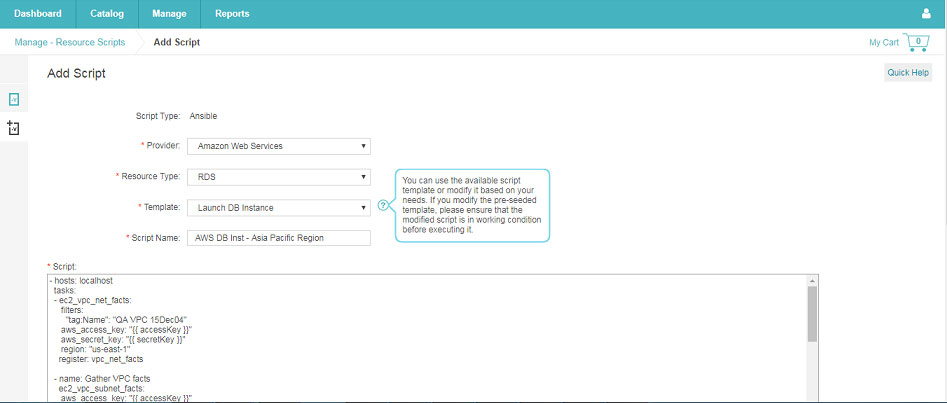
Launching DB instance with Pre-seeded template
Cloud Migration Dashboard
Cloud Migration dashboard provides insights into your private cloud usage and cost, side by side with your public cloud usage and cost. Cloud Migration dashboard enables you to quickly track, analyze and plan your datacenter migration.
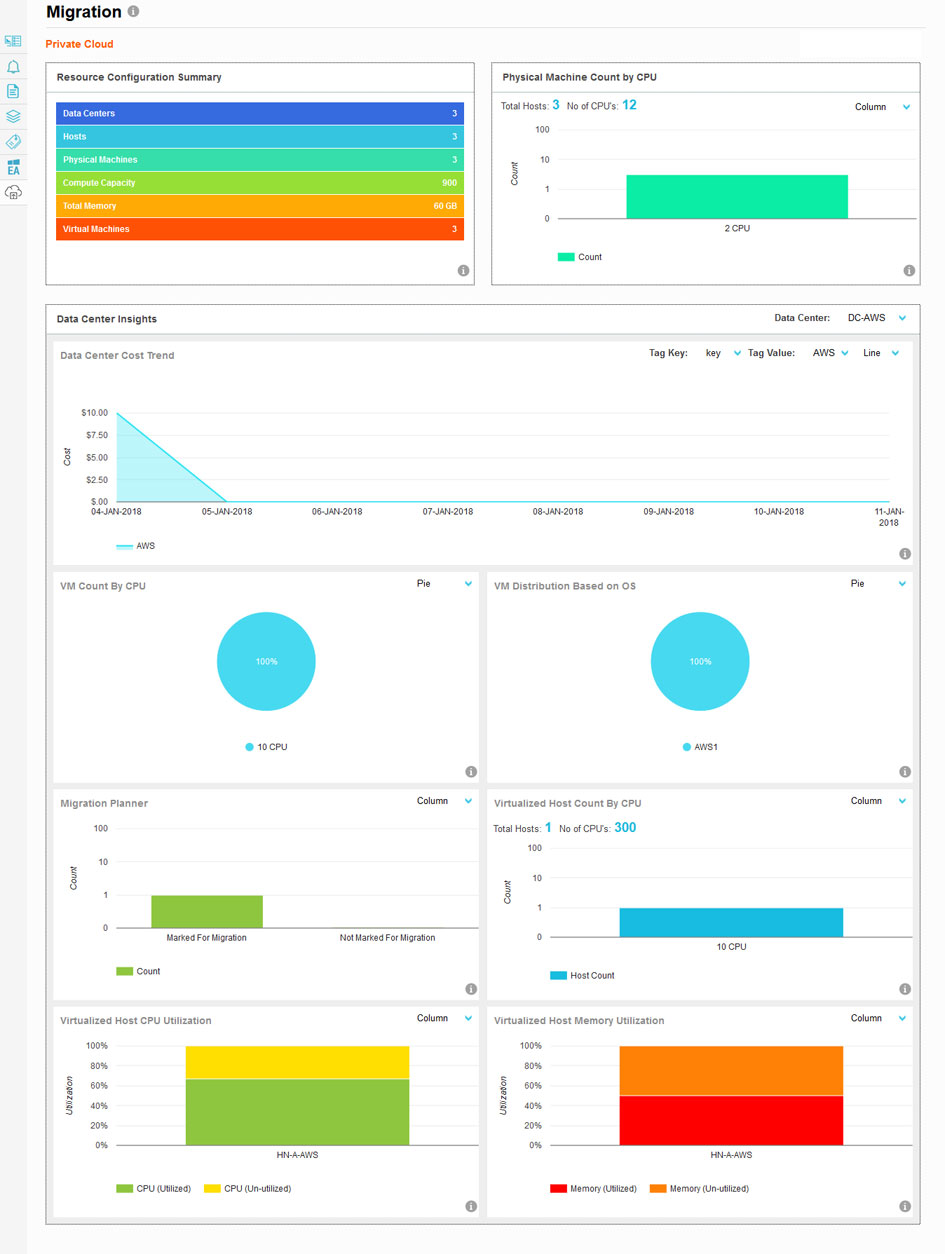
Private Cloud:
Private Cloud section offers the following widgets.
Resource Configuration Summary
This graph provides birds view to your private cloud. By knowing in-depth details of your private cloud resources, plan to migrate to Public cloud accordingly.
Physical Machine count by CPU
This graph details the number Physical Machines based on the CPU for the selected datacenter. The graph allows you to analyze the available compute capacity and hence plan the utilization of the same efficiently. The graph excludes data from the Physical Machines that are suspended.
Data Centre Cost Trend
The data center cost trend graph keeps track of your private cloud cost. Select the project from the filter that you want to migrate and the graph displays the cost of that particular project in the private cloud and help plan migration of the project accordingly.
Note: Make sure to tag the VMs in your private cloud to the respective projects to get most out of this graph.
VM Count based on CPU
To benefit this graph make sure to tag the VMs in your private cloud to the respective projects. Filter the graph based on the project tag and analyze the compute capacity for the selected project. This widget helps you to choose the CPU configuration in the Public cloud while migrating the project.
VM Distribution based on OS
The graph allows you to know what OS to opt for and plan the cost of the migration accordingly. Filter the graph based on the project tag and analyze the OS opted for VMs for the selected project.
Migration Planner
Apply the project tag and plan migration of the projects from your private cloud by knowing the delta between the resources that are planned for migration and the resources that are continued to be in the datacenter.
VM Distribution based on OS
The graph allows you to know what OS to opt for and plan the cost of the migration accordingly. Filter the graph based on the project tag and analyze the OS opted for VMs for the selected project.
Virtualized host count by CPU
The graph briefs you about the compute capacity of the virtualized hosts that are running in the selected datacenter. This widget helps you to choose the CPU configuration in the Public cloud while migrating the project.
Virtualized Host CPU Utilization
The graph helps you to choose the right CPU configuration while migrating a project based on the actual utilization of the CPU in the private cloud. This allows you to equally balance the capacity and utilize the resources efficiently.
Virtualized Host Memory Utilization
The graph helps you to choose the right memory configuration while migrating a project based on the actual utilization of the memory in the private cloud. This allows you to equally balance the capacity and utilize the resources efficiently.
Public Cloud:
Public Cloud section offers the following widgets.
Resource Configuration Summary
Resource Configuration Summary graph provides the summary of the resources, their count and much more for the selected private cloud. Map it against the resource summary of the private cloud and plan the migration.
Cloud Cost Trend
The graph allows you to analyze the cost of the project before and after the migration. To get the most out of this graph make sure to tag the VMs in your public cloud to the respective projects while migrating. Select the project from the filter that has been migrated from the private cloud and the graph displays the cost of the respective project in the public cloud.
VM count by flavors
The size of the virtual machine affects pricing. The size also affects the processing, memory, and storage capacity of the virtual machine. The graph allows you to analyze the configuration opted in the public cloud for the migrated project by selecting the project from the tag filter.
Make sure to tag the VMs in your public cloud to the respective projects while migrating to get maximum benefit out of this graph.
VM distribution based on OS
The graph helps you to analyze the opted OS for the migrated project. Select the project that has been migrated from the tag filter and compares the OS configuration before and after migration.
To get the most out of this graph make sure to tag the VMs in your public cloud to the respective projects, while migrating.
Automating IT Processes with Policy Framework
Organizations can manage and govern their cloud services using the policy framework offered by JSDN. A set of rules can be defined to handle critical business processes and automate tasks. The JSDN framework supports both scheduler driven and event-based rules to manage the resources. Scheduler Driven Policies let customer organizations schedule the execution of various tasks and actions based on time. For example, they can create a policy to start a particular server at a particular time daily. This rule executes every day as per the schedule at the same time. They can also create predefined rules for executing actions when the infrastructure thresholds deviate from their actual base numbers. Customers can define VM scale- out policies. Another example is that a policy can be created to notify the customer when the customer tries to launch more number of VMs than the configured limit.
Policy Enhancements
Additional policy enhancements include:
- The platform allows configuring, a usage-based policy that alerts when the predefined usage amount is reached. This usage amount can be configured either for a Service Provider and specific services like AWS EC2 or Azure Storage. The usage amount is the cumulative usage for the billing cycle and considers the complete usage for all resources provisioned either within the platform or directly from the vendor console
- The platform also allows specifying % Variance field that can send out Alerts when the variance exceeds a predefined % value. So, the current day’s usage is compared against the previous day, and an email is sent out if the variance% exceeds the predefined value.
- For the usage alerts configured at the customer level the notifications will be based on the usage for the respective account
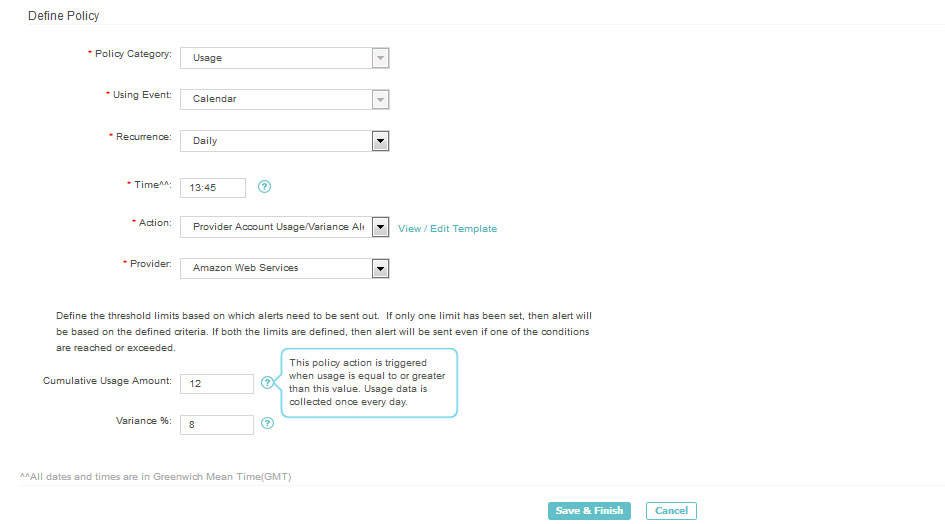
1) To configure and send out alerts based on the variance % in usage.
Usage variance % can be predefined for a Service Provider (like AWS) or for a specific cloud service like AWS EC2. Admins can thus configure the policy to receive real-time alerts when the cumulative usage amount or the daily usage variance % or both, exceed defined limits.
2) Prior to this release, Store Admins would be alerted only based on the usage of their account, without providing visibility on all the accounts of a store. Store Admins can now configure the usage policy to receive alerts based on the consolidated data for all the customers of the store.
An email will be sent to the Store Admin with the breakup displayed for the individual customer accounts registered in the store. This alert is useful to track the cloud spend at a store level with insights about the usage at individual customer accounts.

Note:
- No need to define the mandatory symbol as the system will consider zero.
- If nothing is defined, then everyday alert will be sent as long as usage amount/variance % exceeds 0.
- If only amount is defined, but no variance, then alert whenever usage amount is reached.
- If only variances defined, but no amount is defined then alert whenever variance % is reached.
Admin Dashboard
- Reseller admin can view aggregated analytics pertaining to store, along with the combined data of all the customers, or for a specific customer.
- Enhanced with the ‘Account wise- Revenue Trend’ widget. This data is useful to Admins to monitor the cloud revenue pattern for each IaaS Account under a specific store and take required actions to enhance the cloud revenue.
- The terminology in the widgets can now be changed (as part of the deployment steps) to indicate ‘Revenue’ or ‘Costs’. This feature is useful to Admins based on whether they are using this platform as a Cloud Management Platform or as a Cloud Brokerage Solution.
- Lastly, few widgets in the Admin Dashboard has now been enhanced to display the data in different chart types.
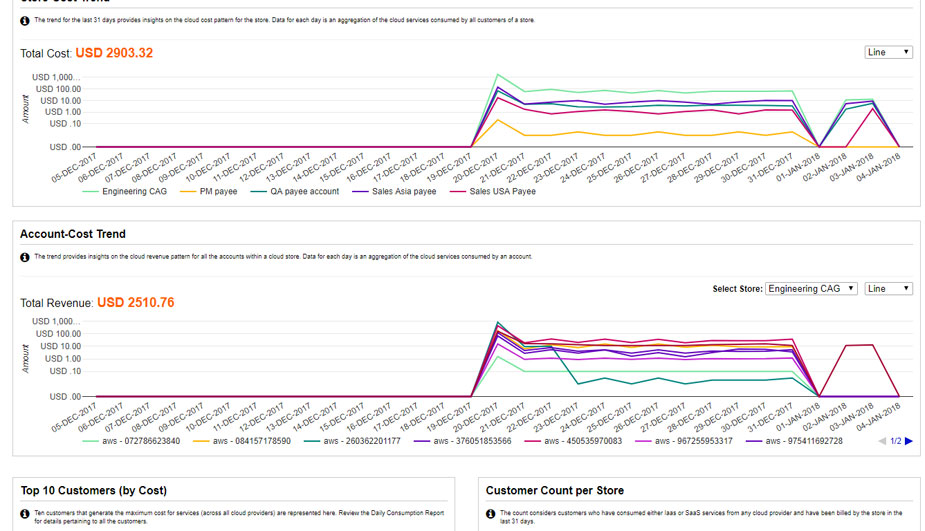
Cloud Cost Comparator
Purchase decision fundamentally relies on one major factor i.e. Price. With JSDN, various IaaS vendors’ offerings in terms of cost can be made available to the customers of the store. The store now has the ability to compare different IaaS provider offerings based on the cost incurred for the same/similar type of VM.
With Cloud Cost Comparator, users of the store will be able to choose the desired VM configuration and instantly get a cost comparison of various public providers’ offerings matching or nearly matching the selection criteria. The configuration chosen by the user shall be matched to get the closest combination from various vendors and the search results fetched are showcased to the end customer. This comparison shall ensure to aid in the decision making for choosing the desired vendor.
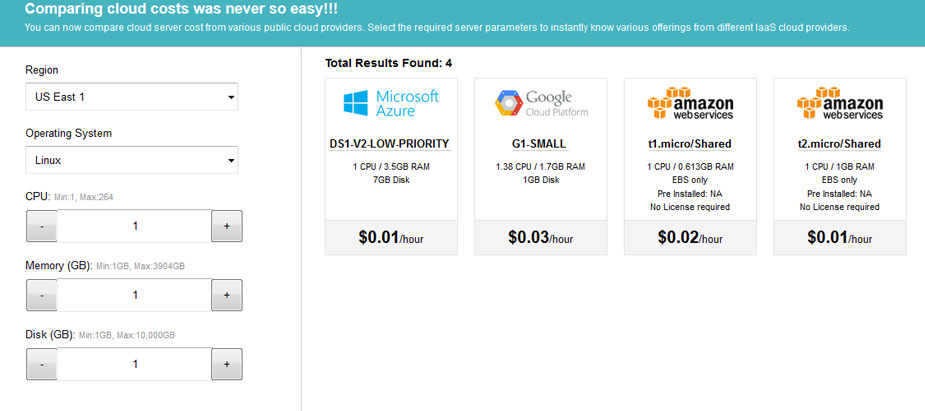
Microsoft Tier 2 import of users and subscriptions
2-Tier Partner and their Resellers can now import all customers from Partner Center to JSDN using the bulk import functionality.
- In each store owned by a Reseller, only the customers of that Reseller and the subscriptions purchased by the customer through that Reseller will be imported.
- For each customer, the CSP SaaS services that they have purchased (supported in JSDN) will be assigned to the customer organization and billing for those subscriptions will now be handled through JSDN.
- Users of the customer organization will also be added in JSDN and the subscriptions will be assigned to the respective users.